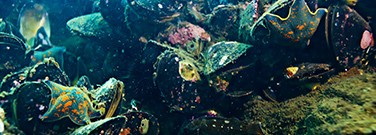New Underwater Glue Makes a Splash

By Christina P. Hooton
Barnacles and mussels have powerful staying power, sticking to any solid surface — and sometimes animals — they encounter. The adhesive abilities of these sea dwellers inspired Tufts University scientists to develop a new, non-toxic underwater glue that may be stronger and more effective than other synthetic options currently available.
Their research required a deep dive into what makes these marine animals stick.
Mussel Muscle
Mussels secrete long, sticky filament bundles called byssus. These embed into surfaces as protein polymers made up of long chains of amino acids. Their bond is strengthened by iron complexes and dihydroxyphenylalanine (DOPA), a catechol-bearing amino acid that can cross-link with the other chains.
Barnacle Bond
Barnacles stick to surfaces by secreting a protein that forms a polymer cement. The amino acid chains that make up these proteins fold into sheets with zig-zag arrangements. This orientation provides flat surfaces for strong hydrogen bonds to form between proteins or the surface to which the polymer is attaching.
Super Silk
To replicate all of this glue power, the team started with silk fibroin protein extracted from silkworm cocoons. Like barnacle cement proteins, silk fibroin can assemble large beta sheet surfaces. The scientists then added polydopamine, a polymer of dopamine, to mimic the cross-linking catechols of mussel adhesive and enhanced the adhesive’s strength by curing it with iron chloride. The iron helps secure inter-catechol bonds, again similar to the mussel adhesive.
Achieving the right combination of silk fibroin, polydopamine, and acidic conditions for curing with iron ions was the key to their success. They created an adhesive that could reach strengths of 2.4 megapascals (MPa), or about 350 pounds per square inch, when met with shear forces underwater. That’s stronger than most existing experimental and commercial adhesives and slightly weaker than the strongest underwater adhesive of 2.8 MPa.
Powerful Potential
In addition to its strength, this adhesive offers significant benefits for real-world use. It’s non-toxic, composed of all-natural materials, and only requires a few drops to achieve its bond. These qualities suggest its potential in industrial, marine, and consumer applications. Fiorenzo Omenetto, Frank C. Doble Professor of Engineering at Tufts School of Engineering and director of the Tufts Silklab, said they were also exploring its use in medicine, thanks to prior success with silk fibroins as a biocompatible material.
Marco Lo Presti, a post-doctoral scholar in Omenetto’s lab and first author of the study, said in a Tufts University news release, “We ended up with an adhesive that even looks like its natural counterpart under the microscope.”
Their results prove once again the power of science imitating nature.
Discussion Questions
- Talk about the different characteristics of the barnacle and mussel adhesives. What other industries or applications could benefit from imitating their properties?
- Research other ways scientists have found inspiration in nature. What are some of the pros and cons of replicating natural models?
Vocabulary
- Polymer
- Amino Acid
- Protein
- Catechol